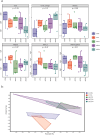The effect of Alpinia oxyphylla essential oil on growth performance, immune, antioxidant functions and gut microbiota in pigs
- PMID: 39720412
- PMCID: PMC11666522
- DOI: 10.3389/fvets.2024.1468520
The effect of Alpinia oxyphylla essential oil on growth performance, immune, antioxidant functions and gut microbiota in pigs
Abstract
Alpinia oxyphylla, a perennial herb belonging to the Zingiberaceae family, has a long history of traditional medicinal use. The present study evaluated the efficacy of different concentrations of Alpinia oxyphylla essential oil (AEO) on the growth performance, serum antioxidation capacities, immune function, apparent digestibility of nutrients, and gut microbiota in fattening pigs. A total of 120 pigs were divided into five treatments, with six replicates each and four pigs per replicate. The pigs were fed a basal diet or basal diet with chlortetracycline (CTC) alone or AEO at 250, 500, and 1,000 mg/kg (referred to as groups AEO1, AEO2, and AEO3, respectively) for 35 days, preceded by a 7-day pre-feed period. The results show that there were no statistically significant differences in growth performance for any dose of AEO supplementation. AEO increased L-DLC content, total protein content and the activity of GSH in serum (p < 0.05). The AEO also exhibited a linear increase in serum IgG content (p < 0.05). Dietary supplementation with AEO improved apparent digestibility of crude ash and calcium (p < 0.05). In gut microbiota, AEO modified the diversity and abundance of bacterial communities in fattening pigs. The abundance of Dorea, Blautia, Butyricicoccus, Bulleidia, and Lactobacillus was higher in the AEO groups compared to the control group, while Clostridium and Turicibacter were lower. The Bifidobacteriales and Pseudomonas were abundant in group AEO1 and AEO3, respectively. In conclusion, dietary supplementation of 1,000 mg/kg AEO has the potential to improve growth performance, immunological, biochemical, and antioxidant statuses. Additionally, AEO can increase the efficiency of nutrient digestion and absorption through the regulation of gut microbiota.
Keywords: Alpinia oxyphylla; antioxidation capacities; essential oil; fattening pig; gut microbiota; immune function.
Copyright © 2024 Chen, Liu, Xie, He, Chen, Peng, Chen, He, Liu, Yang, Kang, He and Lin.
Conflict of interest statement
ZhiL was employed by Hunan Nuoz Biological Technology Co., Ltd. The remaining authors declare that the research was conducted in the absence of any commercial or financial relationships that could be construed as a potential conflict of interest. The reviewer HZ declared a shared affiliation with the author CX to the handling editor at the time of review.
Figures



Similar articles
-
Effects of Litsea cubeba essential oil on growth performance, blood antioxidation, immune function, apparent digestibility of nutrients, and fecal microflora of pigs.Front Pharmacol. 2023 Jul 3;14:1166022. doi: 10.3389/fphar.2023.1166022. eCollection 2023. Front Pharmacol. 2023. PMID: 37465523 Free PMC article.
-
Efficacy of a novel multi-enzyme feed additive on growth performance, nutrient digestibility, and gut microbiome of weanling pigs fed corn-wheat or wheat-barley-based diet.J Anim Sci. 2024 Jan 3;102:skae064. doi: 10.1093/jas/skae064. J Anim Sci. 2024. PMID: 38466229 Free PMC article.
-
Effect of mixed meal replacement of soybean meal on growth performance, nutrient apparent digestibility, and gut microbiota of finishing pigs.Front Vet Sci. 2024 Feb 1;11:1321486. doi: 10.3389/fvets.2024.1321486. eCollection 2024. Front Vet Sci. 2024. PMID: 38362303 Free PMC article.
-
Efficacy of a bacterial 6-phytase supplemented beyond traditional dose levels on jejunal mucosa-associated microbiota, ileal nutrient digestibility, bone parameters, and intestinal health, and growth performance of nursery pigs.J Anim Sci. 2023 Jan 3;101:skad134. doi: 10.1093/jas/skad134. J Anim Sci. 2023. PMID: 37115619 Free PMC article.
-
Effects of dietary supplementation of compound enzymes on performance, nutrient digestibility, serum antioxidant status, immunoglobulins, intestinal morphology and microbiota community in weaned pigs.Arch Anim Nutr. 2021 Feb;75(1):31-47. doi: 10.1080/1745039X.2020.1852008. Epub 2020 Dec 15. Arch Anim Nutr. 2021. PMID: 33317350
References
-
- Heydarian M, Ebrahimnezhad Y, Meimandipour A, Hosseini SA, Banabazi MH. Effects of dietary inclusion of the encapsulated thyme and oregano essential oils mixture and probiotic on growth performance, immune response and intestinal morphology of broiler chickens. Poult Sci J. (2020) 8:17–25. doi: 10.22069/psj.2020.17101.1497 - DOI
-
- Ge C, Luo X, Wu L, Lv Y, Hu Z, Yu D, et al. . Plant essential oils improve growth performance by increasing antioxidative capacity, enhancing intestinal barrier function, and modulating gut microbiota in muscovy ducks. Poult Sci. (2023) 102:102813. doi: 10.1016/j.psj.2023.102813 - DOI - PMC - PubMed
LinkOut - more resources
Full Text Sources
Research Materials
Miscellaneous

